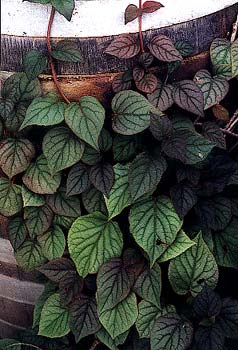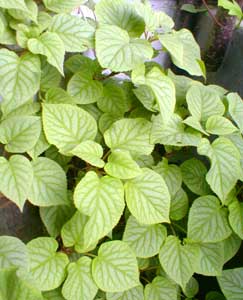
The Evocative
Moonlight Hydrangea Vine
"Moonlight & dew-drenched blossom, & the scent
Of summer gardens; these can bring you all
Those dreams that in the starlit silence fall."
-Siegfried Sassoon
(1886-1967)
(1886-1967)
Schizophragma hydrangeoides 'Moonlight,' the Moonlight Hydrangea Vine, is not a true hydrangea, but its requirements are pretty much the same as for hydrangeas. It wants a partially shaded or dappled sunlight location with moist acid soil. This cultivar is called 'Moonlight.'
It can within a few years cover a ten by ten foot area of a wall or length of fence, & over the longer run might spread as high & wide as twenty feet, so that this cultivar gives about half the coverage one might expect from the species. If planted at the base of a tree it will climb right up, clinging fast to the bark, but will do the tree no harm whatsoever.
It's not an overly aggressive vine & will not harm masonry or walls or other plants, yet it is very good at clinging with its own teency tendrils & requires no trellis or bracing. Its size & thickness is easily maintained by pruning late in the winter or early spring.
 I was warned Moonlight Vine develops slowly, which is certainly the case with the more commonly offered climbing Hydrangea anomala 'Petiolaris.' From a three-foot-tall start with no width, it took a couple seasons to climb all over the rain barrel, then started shooting a few tendrils to the wall of the house, & I was pleased with its initial growth spurt. But three years later, it had covered only about a six foot by six foot area.
I was warned Moonlight Vine develops slowly, which is certainly the case with the more commonly offered climbing Hydrangea anomala 'Petiolaris.' From a three-foot-tall start with no width, it took a couple seasons to climb all over the rain barrel, then started shooting a few tendrils to the wall of the house, & I was pleased with its initial growth spurt. But three years later, it had covered only about a six foot by six foot area.It can also take several years to begin blooming. Moonlight Vine has white lacecap flowers eight to ten inches across, but I haven't yet seen these as only very mature vines bloom. It can take four years before it is well enough established to produce its extravagant July lacecaps. But even without the blossoms, I fell in love with the vine strictly for the sake of the heart-shaped leaves, which seem to have a shimmering silver-pewter glow to them that really does make one think of moonlight.
The moonlit appearance is different through the year. It is sometimes so extreme it looks like someone took silvery paint & airbrushed around the veins of the pallid leaves. When the first photo was taken on a hot July (2002), the leaves were in a darker phase, mostly green, with a few purple leaves brought about by the heat. The second photo from April (2004) shows a lighter phase.
In autumn it has some excellent colors, though ours has shown itself chiefly as yellow. You can view the fall colors on the Moonlight Vine page of the Autumn Leaves Gallery. When the leaves have fallen from the tendrils, the plant is still interesting, as the leafless vines are like ruddy-colored snakes that have fastened themselves flush against the surfaces it is growing on.
There are other cultivars of S. hydrangeoides sold as "Japanese Hydrangea Vines" which do not have the shimmering moonlight effect or outstanding veins, but are nevertheless very pretty. The species vine itself has a larger spread than does 'Moonlight' & could in time cover the whole side of a three story house. A cultivar called 'Brookside Little' has dwarfed leaves. A cultivar with sterile pink flowers is called 'Roseum.' Another species S. corylifolia has oval leaves on red stems & is likewise self-clinging, producing white panicals of flowers. S. integrifolium var. denticulatum has pubescent serated leaves & white panicals with teardrop bracts. Of all these, 'Moonlight' is likely the most appealing because only it has the pewtered moonlit glow, but I wouldn't mind having other varieties too, & recently added the species vine to the edge of our lower sidewalk garden where I expect it someday to cover the face of the sunken gararage.